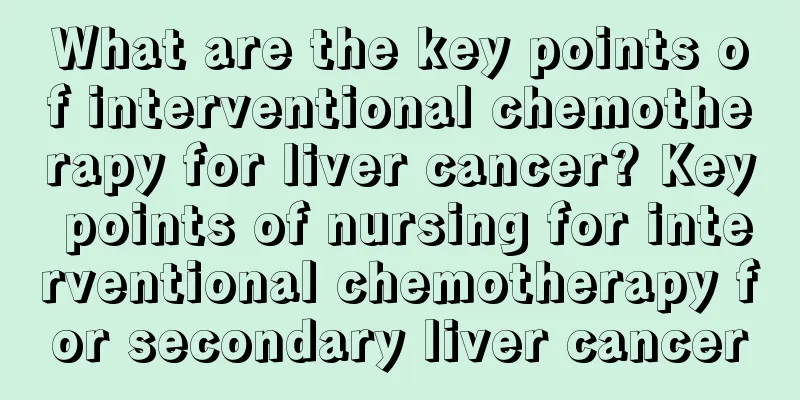What are the key points of interventional chemotherapy for liver cancer? Key points of nursing for interventional chemotherapy for secondary liver cancer

|
Interventional therapy is the use of radiological diagnostic equipment, technology and methods to achieve the purpose of treating diseases, that is, using a cannula and a guide wire to percutaneously puncture and intubate, and inject chemotherapy drugs to achieve the purpose of local administration. Hepatic artery chemoembolization has achieved significant results in the treatment of primary and metastatic liver cancer, and plays a positive role in relieving symptoms and prolonging life. The key points of nursing care for patients undergoing interventional chemotherapy are: (1) Psychological care: Unlike general surgery, interventional chemotherapy does not require anesthesia or laparotomy. It only requires a small incision in the groin under local anesthesia for intubation. It does not cause pain and has a significant effect on the disease, so patients do not need to be nervous or afraid. (2) The main items of preoperative testing are liver and kidney function, including total bilirubin, transaminase, blood urea, blood creatinine, and prothrombin time. (3) Dietary preparation: Do not eat solid or difficult-to-digest food 4 hours before surgery. (4) Skin preparation: Prepare the perineum and clean it with soapy water. (5) Preoperative medication: 10 mg of diazepam and 20 mg of metoclopramide are injected intramuscularly 1 hour before the operation, and 1 ml of 70% diatrizoate is injected intravenously 20 minutes before the operation, and the patient is observed for any allergic reaction. (6) After the operation, the femoral artery puncture site was pressurized with a sandbag for 24 hours, and the lower limbs were immobilized for 24 hours to observe whether there was local bleeding. Blood pressure, pulse, and dorsalis pedis artery pulse were measured every 30 minutes for a total of 4 times. At the same time, hemostatic drugs and antibiotics were routinely used. (7) Postoperatively, patients may experience symptoms such as nausea, vomiting, and diarrhea. Therefore, they should pay attention to dietary adjustment, strengthen nutrition, and provide a high-protein, high-vitamin, and high-nutrition diet. |
>>: What are the early symptoms of lung cancer? Four common early symptoms of lung cancer
Recommend
What should I do if a mole breaks and bleeds?
Some people are troubled by the moles on their bo...
What to do if pores become enlarged after steaming
Sweat steaming is a very good treatment method, b...
Does frequent irregular bleeding mean cervical cancer? There are 4 common symptoms of cervical cancer
Cervical cancer has the highest incidence rate am...
Will swollen gums cause swollen lymph nodes in the neck?
Swollen and painful gums are very common for ordi...
What are the symptoms of lymphoma recurrence and can it be cured?
What are the symptoms of lymphoma recurrence? Can...
Causes of clavicle bone hyperplasia
Osteophyte is a very common bone disease. With in...
What is Lynch syndrome
Lynch syndrome is a genetic disorder that increas...
How much does thyroid cancer cost
In recent years, there are quite a few patients w...
What are the symptoms of acute myocardial infarction?
Acute myocardial infarction is a particularly har...
Why do I feel so weak?
Many people often feel weak all over. They should...
What to do with early breast cancer
What to do with early breast cancer? Early breast...
Thigh ligament pain
Pain can occur in any part of the body and has no...
Can pregnant women drink jasmine tea?
Jasmine tea is a type of tea that has always been...
What is the cause of sore throat
Throat pain can be caused by a wide range of dise...
What are the predisposing factors for tongue cancer? Pay attention to these 3 common things
Tongue cancer is related to bad eating habits suc...









